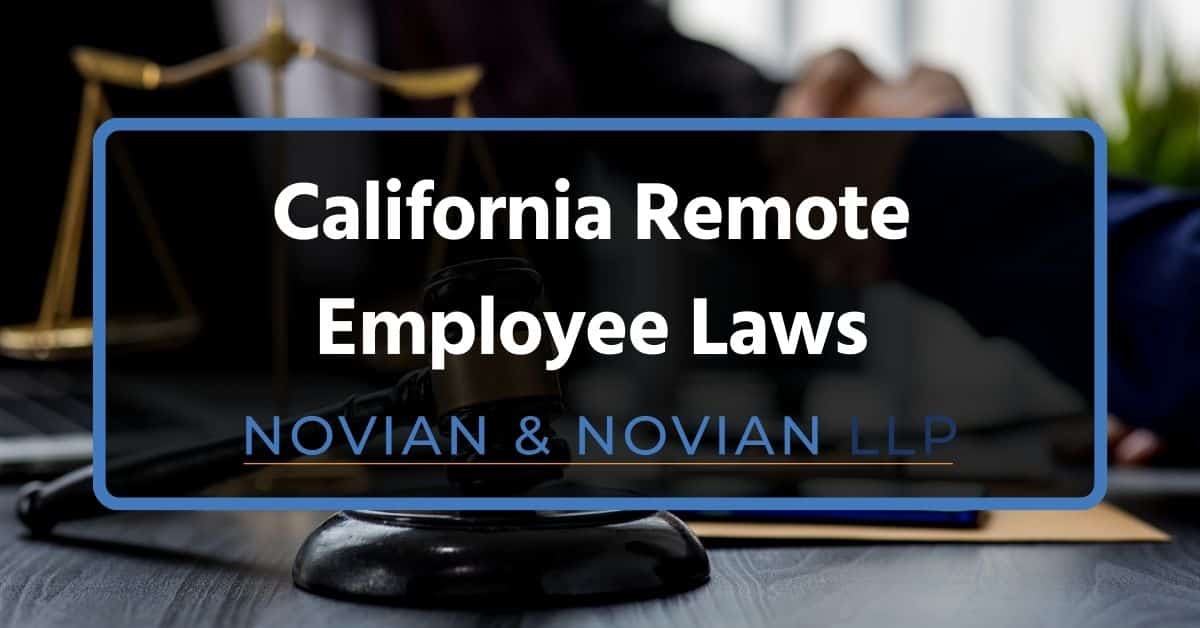

A noteworthy phenomenon characterizing this new digital age is the increasing trend toward remote work. Many employers and employees have since left behind the company office, opting instead for the remote setting. The numerous ever-evolving technological advancements of today made it possible to transition to this new system of employment. This has completely moved the power dynamic of the workplace from in to out of the office. However, compared to the massive shift happening technologically, California’s old employment law was not tailored to regulate these new changes.
That is why the California Labor Code was revised to include telecommuting policies, in order to deal with the trend of this type of work. This new law is crucial for employers to maintain legal compliance and create a positive work experience for those not physically in the office.
At Novian & Novian LLP, we have over 30 years of experience in providing legal services to defend our clients in numerous industries including employment, real estate, venture capital, technology, health care, insurance, and hospitality. Novian & Novian LLP employs business-minded litigators who take practical approaches to complex issues to resolve things swiftly and efficiently without burying clients with unnecessary legal fees. As Los Angeles Employment attorneys, our passion for seeking justice for employers has enabled us to build a strong track record of success for our clients.
Ranging from the classification of remote workers to the employment laws for remote work, this blog post is to inform employers and employees about key legal aspects in employment law cases and the many things an employer considers when creating an effective workplace culture. However, if you would like to inquire more about California laws on this topic, don’t hesitate to contact us today!
Since the COVID-19 Pandemic, about 14% of the people living in California now work remotely for an eight-hour shift. It is reported that about 21% of the workforce is working on hybrid (a system that represents a mix of remote and in-person work), whilst 61% of California’s working population is working physically present in the office.
Pre-pandemic, remote work in California was already growing, notably in tech, finance, and professional services. The state’s tech industry, centered in San Francisco, influenced flexible work arrangements. The COVID-19 pandemic accelerated global remote work adoption, with California businesses implementing remote policies for social distancing. The tech sector’s importance for remote work intensified during the pandemic. Hybrid work models emerged, reflecting a changing perspective on flexibility. Remote work brought flexibility but posed challenges in maintaining culture and collaboration. Urban centers felt the impact as office space demand dwindled, ultimately prompting some companies to reassess their needs. California’s government considered policy and legislative changes related to remote work, addressing taxation, labor laws, and workers’ rights.

A remote employee is someone who performs their job duties from a location other than a central office operated by an employer. An employer requires remote workers to be able to separate their home life from their work life. A remote employee must not allow their home environment to impede on his or her duties, whilst the employer must provide accurate compensation for the work done.
For a remote employee, the company withholds tax, Social Security, and Medicare from wages paid. Independent contractors do not have their taxes withheld by a company. Independent contractors often own their own businesses and enter into contracts with employers to perform specific duties. Employment and labor laws do not apply to independent contractors. Employers like to use independent contractors because doing so will allow them to avoid expenses typically associated with an employee, such as training, sick leave, promotions, taxes, meal periods, overtime hours, benefits, unemployment insurance, etc.
A remote worker receives the same protections and rights as an in-person worker under California law. California employers must ensure compliance for employees working remotely, which includes meal and rest breaks, overtime, paid time off, and any other rights specific to job performance or location.
The Fair Labor Standards Act (FLSA) is a federal labor law in the United States that establishes certain minimum standards for wages, overtime eligibility, recordkeeping, and child labor. Enacted in 1938, the FLSA is administered and enforced by the Wage and Hour Division (WHD) of the U.S. Department of Labor (DOL).
Key provisions of the Fair Labor Standards Act include:

The California Labor Code Section 2802 is the key statute that addresses an employer’s obligation to reimburse any employee for necessary expenses. It states that employers must indemnify employees for all necessary expenditures or losses incurred by the employee in direct consequence of the discharge of their duties. This could include expenses such as: Internet and phone bills, work-related equipment (e.g., computers, monitors), office supplies, and mileage or transportation costs.
The California Labor Code states that businesses must reimburse employees for reasonable remote work expenses, which include any losses incurred by the employee while performing their duties. California remote employee laws state that employers must decide which expenses qualify for reimbursement. Typically, the reimbursement amount depends on cell phone data, internet access and WI-FI fees, at-home tech expenses, desktop, laptop, and printer purchases, and any other business expenses.
The Occupational Safety and Health Administration (OSHA) outlines specific requirements for maintaining safety in remote work environments. Employers are obligated to extend their commitment to workplace safety to remote settings.

Here are key considerations according to OSHA guidelines: (a) Safe Work Environment: An employer must ensure that a remote worker is free from recognized hazards that could cause harm. This includes providing necessary equipment and ensuring that the work environment is adequate thus ensuring safe and healthy practices; (b) Ergonomics and Equipment: An employer is responsible for evaluating and addressing ergonomic factors in remote workstations. This involves providing suitable furniture, equipment, and accessories to promote comfortable and safe working conditions; (c) Training and Guidelines: Employers should offer appropriate training to remote workers, outlining safety protocols and guidelines. This may include information on emergency procedures, proper equipment usage, and hazard identification; (d) Communication: Employers must establish effective communication channels to stay connected with remote workers. This ensures that employees can promptly report safety concerns or incidents, allowing for timely resolution; (e) Data Security and Privacy: In accordance with OSHA guidelines, employers should implement measures to secure sensitive information and uphold data privacy in remote work settings. This involves secure remote access, data protection training, and clear policies on handling confidential information; (f) Workers’ Compensation: Remote workers who sustain work-related injuries or illnesses should be informed about the procedures for reporting and filing workers’ compensation claims. Employers must maintain transparency about the available benefits and support for injured or ill remote workers; (g) Regulatory Compliance: Employers need to comply with relevant OSHA regulations, even in remote work arrangements. This includes staying informed about any updates or changes in OSHA requirements and adjusting policies applying to remote workers accordingly.
By adhering to these OSHA requirements, employers can create and maintain safe remote work environments, prioritizing the health and well-being of their employees.
Employers bear the responsibility of ensuring a secure work environment for a remote employee, encompassing the provision of appropriate equipment, ergonomic setups, and resources to execute their job responsibilities safely. It may be necessary for employers to conduct assessments or furnish guidelines to remote workers, ensuring the maintenance of a safe and healthy workspace.
Additionally, employers should take steps to safeguard sensitive information and guarantee data privacy and security for remote workers. This involves the implementation of secure remote access systems, offering training on data protection practices, and establishing policies for the handling of confidential information. Adherence to data protection regulations may also be obligatory. In the event of work-related injuries or illnesses, remote workers may qualify for workers’ compensation benefits. Employers should make certain that remote workers are familiar with the procedures for reporting and filing workers’ compensation claims

It is crucial for California employers to ensure the security and confidentiality of sensitive information and follow labor laws. In California, the California Consumer Privacy Act (CCPA) is a data protection law enforced to maintain data security in operations.
Employee privacy rights can vary depending on the jurisdiction, industry, and specific employment agreements. Employers need to be aware of applicable laws and respect the privacy rights of employees. Here are some common considerations related to employee privacy rights:
Privacy Policies: Employers should have clear and transparent privacy policies that outline the types of personal information collected, how it will be used, and any third parties with whom it may be shared.
Consent: Obtain informed consent from employees before collecting and processing their personal information. Clearly communicate the purpose of data collection and seek permission where required.
Monitoring: If monitoring of employees is necessary, employers should communicate the extent and nature of monitoring activities. This includes monitoring electronic communications, internet usage, and workplace surveillance.
Data Security: Employers have a responsibility to secure and protect the personal information of employees. Implement measures such as encryption, access controls, and secure storage to safeguard any data.
Background Checks: When conducting background checks on potential or current employees, adhere to legal requirements and obtain consent. Inform employees about the purpose and scope of the background check.
Personal Devices: Clarify policies regarding the use of personal devices for work-related activities. Balance the need for security with respecting the privacy of personal information on employee-owned devices.
Communications: Be mindful of monitoring employee communications, such as emails and messages. Some jurisdictions have strict rules about intercepting and monitoring electronic communications.
Social Media: Respect employees’ rights to privacy on social media. Avoid requiring employees to provide access to their personal social media accounts, as this may infringe on privacy rights.
Records: Maintain accurate and up-to-date employee records. Employees generally have the right to access their own personnel files, and employers should handle this information responsibly.
Location Tracking: If location tracking is necessary, such as for remote work arrangements, be transparent about the purpose and obtain consent where required.
Training: Educate workers about privacy policies and their rights. This can include training on data protection, acceptable use of technology, and the importance of maintaining confidentiality.
California’s anti-discrimination and harassment laws extend to remote work, ensuring that employers are obligated to maintain a safe and inclusive work environment, irrespective of the physical location of their employees. Employers must uphold anti-discrimination and harassment policies, conduct trainings, and promptly address any complaints. Remote workers are entitled to the same legal protections as regular office employees, safeguarding them from discriminatory practices or harassment based on factors such as race, gender, sexual orientation, or disability. It remains crucial for employers to stay compliant with these laws, fostering a work culture that prioritizes equality and protects employees from any form of discrimination or harassment.

Employer withholding and reporting obligations include:
Residency Rules:
Telecommuting Policies:
Withholding for California Residents:
Withholding for Nonresidents:
Reciprocal Agreements:
Employee’s Responsibility:
Recordkeeping:
Reporting Obligations:
Crafting a legally compliant remote work policy involves addressing crucial elements such as labor laws, expense reimbursement, and privacy regulations, ensuring alignment with California’s specific mandates. Employers should clearly define expectations regarding working hours, breaks, and overtime, while also implementing a robust system for reimbursing remote employees for necessary business expenses. Best practices include seeking legal advice to tailor policies to individual organizational needs, staying informed on evolving remote work laws, and fostering open communication with employees to maintain a legally sound and supportive remote work environment.
Remote work presents a myriad of legal challenges spanning privacy, wage and hour compliance, and discrimination, exemplified by lawsuits over overtime compensation arising from blurred work-life boundaries. Data security concerns arise due to personal device use, potentially resulting in legal consequences for compromised sensitive information. Workplace discrimination in virtual settings necessitates proactive company measures, while challenges related to remote monitoring policies, accommodation of disabilities, and compliance with state employment laws further contribute to the complex legal landscape of remote work.
To accommodate for the fact that employment law is constantly evolving, an employer must have clear communication with their employees, providing them with flexible work hours, remote onboarding, giving regular feedback, following local ordinances, and having data protection and compliance regulations in place.
Understanding and adhering to California law is crucial to ensure legal compliance and foster a positive work environment. With the state’s stringent regulations on labor, expense reimbursement, and privacy, employers must navigate these complexities to avoid legal consequences.
Seeking legal advice is highly encouraged, especially in specific situations such as expense reimbursement and worker classification, where missteps can lead to serious repercussions.
Consulting with an employment attorney will provide invaluable guidance, helping many employers tailor their remote work policies to align seamlessly with California law and ultimately contribute to a successful and legally sound remote work setup.
As Los Angeles Employment attorneys, our passion for seeking justice for employers has enabled us to build a strong track record of success for our clients. Contact us today for a free consultation!
Have questions about this post? Novian & Novian is a full service law firm in Los Angeles with clients that span the country. Contact us today for a free consultation.
Have questions about this post? Novian & Novian is a full service law firm in Los Angeles with clients that span the country. Contact us today for a free consultation.